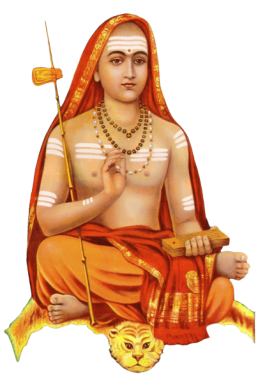सर्वात्मभावान्न परोऽस्ति कश्चित् ।
दृश्याग्रहे सत्युपपद्यतेऽसौ
सर्वात्मभावोऽस्य सदात्मनिष्ठया ॥ ३३९ ॥
sarvātmabhāvānna paro’sti kaścit |
dṛśyāgrahe satyupapadyate’sau
sarvātmabhāvo’sya sadātmaniṣṭhayā || 339 ||
बाह्यार्थानुभवप्रसक्तमनसस्तत्तत्क्रियां कुर्वतः ।
संन्यस्ताखिलधर्मकर्मविषयैर्नित्यात्मनिष्ठापरैः
तत्त्वज्ञैः करणीयमात्मनि सदानन्देच्छुभिर्यत्नतः ॥ ३४0 ॥
bāhyārthānubhavaprasaktamanasastattatkriyāṃ kurvataḥ |
saṃnyastākhiladharmakarmaviṣayairnityātmaniṣṭhāparaiḥ
tattvajñaiḥ karaṇīyamātmani sadānandecchubhiryatnataḥ || 340 ||
^gfrīJTpFTS-q- fíT^T. f^tSJiTWSmTTr. II
*mrni f^î’«rr^TT W’Á r sr^r rrá sxm: Il2’2>
341. To the Sannyasin who has gone through the act of hearing, the Sruti passage, “Calm, self-controlled’1 etc., prescribes Samadhi, for his realisation of the universe as his own self.
Hearing—the truth from the lips of the Guru, after the prescribed manner.
“Calm, self-controlled" ÖY.—The reference is to Brihadaranvaka Upanishad I V. iv. 23.
समाधिं विदधात्येषा शान्तो दान्त इति श्रुतिः ॥ ३४१ ॥
samādhiṃ vidadhātyeṣā śānto dānta iti śrutiḥ || 341 ||
कर्तुन्न शक्य सहसापि पण्डितैः ।
ये निर्विकल्पाख्यसमाधिनिश्चलाः
तानन्तरानन्तभवा हि वासनाः ॥ ३४२ ॥
kartunna śakya sahasāpi paṇḍitaiḥ |
ye nirvikalpākhyasamādhiniścalāḥ
tānantarānantabhavā hi vāsanāḥ || 342 ||
विक्षेपशक्तिः पुरुषं विक्षेपयति तद्गुणैः ॥ ३४३ ॥
vikṣepaśaktiḥ puruṣaṃ vikṣepayati tadguṇaiḥ || 343 ||
निःशेषमावरणशक्तिनिवृत्त्यभावे ।
दृग्दृश्ययोः स्फुटपयोजलवद्विभागे
नश्येत्तदावरणमात्मनि च स्वभावात्
निःसंशयेन भवति प्रतिबन्धशून्यो
विक्षेपणं नहिं तदा यदि चेन्मृषार्थे ॥ ३४४ ॥
niḥśeṣamāvaraṇaśaktinivṛttyabhāve |
dṛgdṛśyayoḥ sphuṭapayojalavadvibhāge
naśyettadāvaraṇamātmani ca svabhāvāt
niḥsaṃśayena bhavati pratibandhaśūnyo
vikṣepaṇaṃ nahiṃ tadā yadi cenmṛṣārthe || 344 ||
विभज्य दृग्दृश्यपदार्थतत्त्वम् ।
छिनत्ति मायाकृतमोहबन्धं
यस्माद्विमुक्तस्तु पुनर्न संसृतिः ॥ ३४५ ॥
vibhajya dṛgdṛśyapadārthatattvam |
chinatti māyākṛtamohabandhaṃ
yasmādvimuktastu punarna saṃsṛtiḥ || 345 ||
दहत्यविद्यागहनं ह्यशेषम् ।
किं स्यात्पुनः संसरणस्य बीजं
अद्वैतभावं समुपेयुषोऽस्य ॥ ३४६ ॥
dahatyavidyāgahanaṃ hyaśeṣam |
kiṃ syātpunaḥ saṃsaraṇasya bījaṃ
advaitabhāvaṃ samupeyuṣo’sya || 346 ||
मिथ्याज्ञानविनाशस्तद्विक्षेपजनितदुःखनिवृत्तिः ॥ ३४७ ॥
mithyājñānavināśastadvikṣepajanitaduḥkhanivṛttiḥ || 347 ||
तस्माद्वस्तुसतत्त्वं ज्ञातव्यं बन्धमुक्तये विदुषा ॥ ३४८ ॥
tasmādvastusatattvaṃ jñātavyaṃ bandhamuktaye viduṣā || 348 ||
Vivekachudamani – Introduction
1: Devoted Dedication
2: Glory of Spiritual Life
3: Unique Graces in Life
4-7: Miseries of The Unspiritual Man
8-13: Means of Wisdom
14-17: The Fit Student
18-30: The Four Qualifications
31: Bhakti – Firm and Deep
32-40: Courtesy of Approach and Questioning
41-47: Loving Advice of the Guru
48-49: Questions of the Disciple
50: Intelligent Disciple – Appreciated
51-55: Glory of Self-Effort
56-61: Knowledge of the Self-Its Beauty
62-66: Direct Experience – Liberation
67-71: Discussion on Questions Raised
72-75: Gross Body
76-82: Sense Objects a Trap – Man Bound
83-86: Fascination for Body Criticised
87-91: Gross Body Condemned
92: Organs of Perception and Action
93-94: Inner Instruments
95: The Five Pranas
96-101: Subtle Body – Effects
102: Functions of Prāna
103-105: Ego Discussed
106-107: Infinite Love – the Self
108-110: Māyā – Pointed Out
111-112: Rajoguņa – Nature and Effects
113-116: Tamoguņa – Nature and Effects
117-119: Sattvaguņa – Nature and Effects
120-121: The Causal Body – Its Nature
122-123: Not-Self – Description
124-135: The Self – Its Nature
136: Advice for Self-control
137-142: What is Bondage – The Reply
143-144: The Powers – Agitation and Veiling
145-146: Bondage in Action
147-153: Ātman and Anātman – Discrimination
Negation of the Kośas
154-164: – Annamaya kośa (Food sheath)
165-166: – Prņamaya kośa (Vital air sheath)
167-183: – Manomaya kosa (Mental sheath)
184-188: – Vijnanamaya kośa (Intellectual sheath)
189-191: Ātman – Unattached
192-193: What is Liberation? – Disciple
194-206: Self-Knowledge gives Liberation
207-210: Anandamaya kośa (Bliss sheath)
211: Ātman – Other than the Five Kośas
212: What is Ātman? – Disciple
213-225: Nature of the Self – Discussion
226-236: All Manifestation Absolute
237-240: Brahman – Its Nature
241-249: That Thou Art – Explanation
250-253: Attitude in Meditation
254-266: Aids to Meditation
267-276: Give up Vāsanās – the Method
277-292: End Superimposition – The Means
293-297: The Perceived I’ Factor – False
298-309: Condemnation of the Ego
310-319: Actions, Thoughts and Vāsanās – Renounce
320-329: Total Vigilance – Its Price
330-338: In the One, No Plurality
339-348: Spiritual Growth – the Secret
349-353: Cause-Effect – False
354-372: Samadhi – Its Nature
373-378: Fully Detached – Samadhi Easy
379-383: Meditation – the Technique
384-397: Continuous Attention to Self
398-406: No Diversity in Reality
407-413: Ātma-vicāra – Contemplation
414-418: Give up Perceptions
419-425: The Science of Reality – Its Benefits
426-445: Signs of a Realised Seer
446-464: Prārabdha for a Saint
465-471: There is No Plurality
472-479: Experience of Selfhood
480-520: Practice of Knowledge – Disciple
521-575: Final Words of Advice
576-578: Blessed Disciple Liberated
579-581: The Glory of the Textbook

Vivekachudamani – Verses 339-348 – Vivekachudamani Verses 339-348 – By Adi Sankaracharya – In Sanskrit with English Meaning, Transliteration, Translation, Commenary, Lyrics, Audio – Vivekachudamani-339-348
